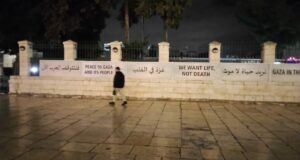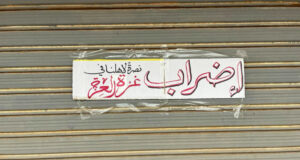15 August 2011 | International Solidarity Movement, West Bank
The so called “price tag” campaign is regarded to be a product of the illegal Israeli settlement of Yitzhar, yet the price tag to Israeli occupation and fanatical land grabbing is much more a general concept, aligned with the policy and practice of Israel let alone its illegal settlements. The “price tag” campaign, after all, is the settler pursuit to claim as much indigenous land while terrorizing Palestinians with arson, gunfire, vandalizing, and other forms of harassment resulting in even death. While Israelis may domestically see a difference between illegal settlers and the State, the Palestinian who loses self-autonomy and land ownership by military or by fanatical settlers never was able to tell the difference between what seems to be a mutual sharing of a national agenda.
The term “price tag campaign” is a so called phenomenon that comes as a reaction to the demolition of settler construction by Israel, with illegal settlers seeking revenge for such destruction on innocent, Palestinians of nearby villages. If Israel is destroying small structures within settlements, one might think it is taking a step towards stopping the settlement projects. Yet despite the illegal status of settlements, Israel continues to include them in official “national priority maps” with soldiers at hand to protect illegal pursuits at the cost of Palestinian rights and peace. Thus the price tag campaign is nothing more than a pattern in illegal Israeli occupation.
In mid-2010 illegal structures in the illegal settlement of Bay Ayen near the Palestinian village of Beit Ommar were destroyed by Israeli military. Settlers attacked the Safaa neighborhood of Beit Ommar in what became to be a systematic and regular pursuit to destroy groves with arson, damage buildings, and threaten the overall security of locals. When the Israeli military showed up during one particular instance, it arrived just as residents of the Palestinian village began to leave their homes to see what was going on.
The Israeli military fired tear gas and stun grenades at the Palestinians, injuring a number of residents while the assailants left protected and not apprehended
The Palestinian village of Burin can also attest to the relationship between Israeli military and Israeli settlers. In 2009 for example, a group of international observers saw about 50 settlers descend from their illegal settlement carrying rifles and assaulting the 13 members of Ghalib Najjar’s household. When the Israeli military showed up and allowed the settlers to leave without consequence, the military threatened the international observers from reporting or photographing the event. Snipers were positioned at the top of the family home, and international observers were threatened to be detained.
Islam Fakhuri currently living in the H1 area of Hebron, also reveals the collaboration between settlers and Israeli military forces.
“My father had two shops – souvenior shops—on Shuhada Street In 2000 under the intifada, the army came into our house one day and they said they want to buy our house. I said, ‘this house is not for sale. We don’t want to sell our house to you, not to settlers.’
Fakhuri continued to describe what formulated to be settler and military collaboration.
“That night around 2am, they came back and set our house on fire. Two children of my family sleeping in one room died from the fire. And then the army came back and forced us to move out. You see, my house is empty now. Everyone has the same story like mine. You can speak to Abd Sadr. The children from his family died from that, too.”
He pointed to a building nearby to illustrate his experiences.
“You see the building up there, it was the office for lawyers and doctors, and now settlers live there. Beit Haddasah and Abram Avinu used to be a hospital for Palestinians. No more.”
These violent actions occur almost weekly, outlining various villages throughout the West Bank with some Israelis even calling on the Israeli military to act more responsibly. But how can one ask a military to act responsibly when its State continues to violate international law and disregard Palestinian rights?
Whether one is looking at Nabi Saleh, the Jordan Valley, Hebron, Sheikh Jarrah, and the places erased of names and labeled in the language of imperialists—it is clear.
The colonial state has merely birthed violent colonialists who take it upon themselves to do what the Israeli military traditionally does. And thus, to the Palestinian both are the same.
One wears fatigues, but the two carry guns.
 International Solidarity Movement Nonviolence. Justice. Freedom.
International Solidarity Movement Nonviolence. Justice. Freedom.


